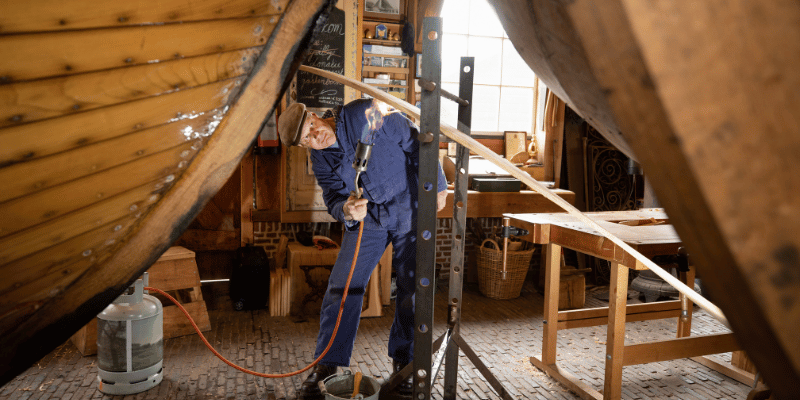Wood bending is a remarkable technique that allows craftsmen, builders, and DIY enthusiasts to create intricate and elegant designs that might otherwise be impossible with straight lumber. Whether it’s for furniture, musical instruments, or architectural embellishments, the art of bending wood opens up a world of creative possibilities.
To bend wood, start by selecting a suitable wood type, such as oak or ash. Soak the wood in water or steam to increase its flexibility. Secure the wood in a bending form or jig, applying pressure gradually. Use clamps to hold the wood in place until it dries and retains the desired shape.
Use a kerfing technique by making evenly spaced cuts along the back of the wood. Apply steam or water to the cuts, and gently bend the wood while it’s still pliable. Allow the wood to dry in the desired shape.
In this guide, we will delve into various methods and tools that can be employed to bend wood effectively, exploring both traditional and contemporary techniques that cater to a diverse range of projects and skill levels. From steam bending to lamination, understanding the fundamentals of this process will empower you to bring your envisioned designs to life with finesse and precision.
Steps to Bend Wood in No Time:
Bending wood can be a challenging yet rewarding technique in woodworking, allowing for the creation stunning and unique designs. There are several methods for bending wood, each with its own benefits and considerations. Here’s a step-by-step guide to help you master the art of bending wood:
Step 1: Wood Selection
Choose the right type of wood for your project. Generally, woods with more flexible fibers, such as ash, oak, and walnut, are easier to bend. Avoid using woods prone to splitting, like maple or birch, unless you are experienced in wood bending.
Step 2: Moisturizing the Wood
Moisten the wood to increase its flexibility. One method is to submerge the wood in water for a few hours or overnight. Alternatively, you can use a wet cloth or towel to cover the wood, allowing it to absorb moisture gradually.
Step 3: Steam Bending
If you opt for steam bending, build a steam box large enough to accommodate the wood. Place the wood inside the steam box and apply steam for the appropriate duration, depending on the wood species and thickness. Remove the wood from the steam box and bend it into the desired shape immediately.
Step 4: Kerf Cutting
For simpler bends, consider the kerf-cutting technique. Make evenly spaced cuts along one side of the wood to increase its flexibility. Be cautious not to cut too deeply, as this can weaken the wood’s structure.
Step 5: Lamination Technique
Lamination involves gluing thin strips of wood together to form a curved shape. Cut the wood into thin strips, apply glue between each layer, and clamp them together in the desired curve. Allow the glued layers to dry thoroughly before removing the clamps.
Step 6: Forming Jigs
Create custom jigs or molds to help hold the wood in the desired shape as it dries or cools. Ensure that the jig provides even pressure to prevent the wood from springing back to its original form.
Step 7: Drying and Finishing
Allow the wood to dry completely in its new shape, ensuring it retains the desired curve. Sand the wood to achieve a smooth finish, and apply a suitable finish or sealant to protect the wood and enhance its appearance.

Best Types of Wood For Steam Bending:
Steam bending is a technique used to shape wood into curved or rounded forms by using steam to soften the wood fibers, making it more pliable. Not all types of wood are suitable for steam bending, as some species have a higher tendency to break or splinter during the process. Understanding the best types of wood for steam bending is crucial for achieving successful and aesthetically pleasing results. Here are some of the best wood species known for their favorable characteristics when it comes to steam bending:
1. White Oak:
Known for its strength and flexibility, white oak is a popular choice for steam bending. It has a straight grain with a coarse texture, making it relatively easy to bend without excessive risk of cracking or splitting.
2. Ash:
Ash is another excellent wood for steam bending due to its inherent flexibility and elasticity. It has a prominent grain pattern and is widely used in furniture making and sports equipment such as baseball bats and hockey sticks.
3. Walnut:
Walnut, while not as commonly used for steam bending as some other species, possesses moderate bending characteristics. Its dark, rich color and smooth grain make it an attractive option for projects requiring curved elements.
4. Hickory:
Hickory is renowned for its exceptional strength and shock resistance. Its flexibility and ability to withstand bending make it a favorable choice for steam bending applications, particularly in the production of furniture and tool handles.
5. Mahogany:
Mahogany, with its straight and interlocked grain, is a stable and reliable wood for steam bending. It is known for its durability, attractive reddish-brown color, and smooth finish, making it a sought-after choice for high-end furniture and interior design.
6. Cherry:
Cherry wood, with its fine, straight grain and smooth texture, is moderately easy to bend with steam. It is a popular choice for furniture making, cabinetry, and musical instruments due to its warm, reddish-brown hues.
7. Beech:
Beechwood, known for its excellent bending properties, is a versatile option for steam bending. It has a pale cream color and a fine, even texture, making it suitable for various woodworking applications.
Bending Wood by Kerf-Cutting:
Bending wood by kerf-cutting is a technique that involves making strategically spaced cuts along one side of a piece of wood to increase its flexibility and facilitate bending. This method is beneficial for creating gentle curves or slight bends in wood without the need for complex equipment or high levels of expertise. Below is a detailed guide on how to bend wood using the kerf-cutting technique:
1. Wood Selection:
Choose a suitable type of wood for your project. While various types of wood can be used for kerf-cutting, it’s essential to select a wood species known for its flexibility and resistance to splitting, such as ash, cedar, or pine.
2. Measurement and Marking:
Measure and mark the areas where you intend to make the kerf cuts. Ensure that the spacing between the cuts is uniform and appropriate for the degree of flexibility required for the desired bend.
3. Setting Up the Saw:
Set up a table saw or a handheld saw with a fine-toothed blade that is appropriate for cutting wood. Adjust the blade to the desired cutting depth, considering the thickness of the wood and the intended curvature.
4. Making Kerf Cuts:
Carefully make straight and evenly spaced cuts along one side of the wood, ensuring that the cuts do not penetrate the opposite side. The depth of the cuts should be around three-quarters of the wood’s thickness, allowing for increased flexibility without compromising the structural integrity of the wood.
5. Moisturizing the Wood:
To further enhance the wood’s flexibility, apply moisture by either using a damp cloth to cover the wood or by lightly spraying water onto the kerf cuts. This step helps prevent the wood from splintering or cracking during the bending process.
6. Bending the Wood:
Slowly and gently bend the wood to the desired shape, taking care not to force it beyond its natural bending capacity. Use clamps or a jig to hold the wood in place as it dries to maintain the desired curvature.
7. Drying and Finishing:
Allow the wood to dry completely in its new shape. Once dry, sand the wood to smoothen any rough edges or surfaces created during the bending process. Apply a suitable finish or sealant to protect the wood and enhance its appearance.
FAQs:
What is the best method for bending wood?
The most suitable method for bending wood depends on the specific project and the desired curvature. Techniques such as steam bending, kerf-cutting, and lamination are commonly used, each offering unique advantages based on the complexity and intended outcome of the woodworking project.
Can any type of wood be bent?
Not all types of wood are suitable for bending. Some wood species, like ash, oak, and walnut, are more flexible and suitable for bending, while others, such as maple and birch, are prone to splitting and are more challenging to bend without breaking.
How do you prevent wood from cracking during the bending process?
To prevent cracking, it’s crucial to increase the wood’s flexibility by adding moisture and using appropriate techniques such as steaming, kerf-cutting, or lamination. Additionally, carefully controlling the bending pressure and ensuring the wood’s uniform temperature distribution can help prevent cracking.
Can wood be bent without special equipment?
Yes, certain wood bending techniques, such as kerf-cutting or lamination, can be done with basic woodworking tools and minimal equipment. However, more complex bends may require specialized tools like steam boxes, clamps, or forms.
What are some common applications of bent wood in woodworking projects?
Bentwood finds application in various woodworking projects, including furniture making, musical instrument construction, architectural elements, and artistic installations, enabling the creation of unique and aesthetically appealing designs that may not be achievable with straight lumber.
How long does it take to bend wood using steam?
The time required for steam-bending wood varies depending on the wood species, thickness, and moisture content. Generally, it can take anywhere from 30 minutes to several hours, considering the specific requirements of the wood and the desired curvature.
Can the shape of the wood be permanently set after bending?
Yes, the shape of the wood can be permanently set by allowing the wood to dry or cool in the desired shape. Using appropriate clamping or forming jigs during the drying process can help maintain the intended curvature.
What factors should be considered when selecting wood for bending?
When selecting wood for bending, consider the wood species, moisture content, grain orientation, and thickness. It’s important to choose a wood type that is known for its flexibility, strength, and resistance to splitting to ensure successful bending results.
What are the main challenges in bending wood?
Some common challenges in bending wood include the risk of wood splitting or cracking, difficulty achieving consistent curvature, and the need for precise control over moisture and temperature during the bending process.
How can I ensure the safety of the wood bending process?
Ensuring safety during the wood bending process involves using appropriate protective gear, following proper handling techniques for tools and equipment, and understanding the specific risks associated with each bending method. Additionally, maintaining a clean and organized workspace can help prevent accidents and injuries.
Conclusion:
In conclusion, mastering the art of bending wood not only expands the horizons of craftsmanship but also unlocks the potential for innovation and creativity in woodworking projects. Whether one chooses to utilize the time-honored techniques of steam bending or opts for modern methodologies like laminating thin layers of wood, the key lies in understanding the properties of different wood species and the principles that govern their malleability.



2 thoughts on “How To Bend Wood?”